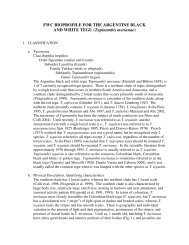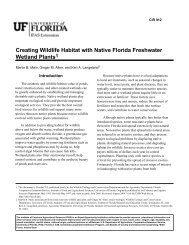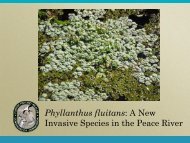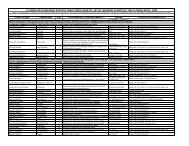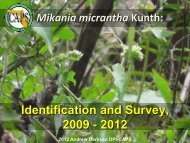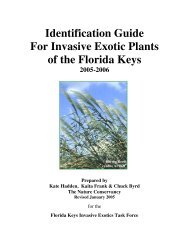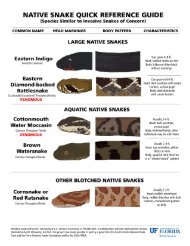Graminoids (Families Poaceae, Juncaceae and Cyperaceae)
Graminoids (Families Poaceae, Juncaceae and Cyperaceae)
Graminoids (Families Poaceae, Juncaceae and Cyperaceae)
You also want an ePaper? Increase the reach of your titles
YUMPU automatically turns print PDFs into web optimized ePapers that Google loves.
Family <strong>Cyperaceae</strong> (The sedges):<br />
There are numerous genera within the family <strong>Cyperaceae</strong> that you will encounter at DWP. We will discuss<br />
the family characteristics in general <strong>and</strong> three genera within the family. Examples of sedges, <strong>and</strong> their<br />
flower structure, are shown in the illustration below.<br />
The key to the most common genera of sedges you will encounter at DWP is provided. However, there are<br />
numerous genera not listed in this key that are present at DWP (e.g. Fimbristylis, Fuirena, Bulbostylis,<br />
Dulichium, Kyllinga <strong>and</strong> Scirpus), so use this key with that fact in mind. You will use this key during<br />
exercises designed to familiarize you with this group. A more detailed discussion of Cyperus, Carex <strong>and</strong><br />
Rhynchospora follows.<br />
1 Achene enclosed in a sac (perigynium), with style <strong>and</strong> stigmas protruding through a terminal opening;<br />
flowers unisexual, the staminate flowers either above or below the pistillate in the same or separate<br />
spikelet, leaf blades with a midrib…………………………………………………………………….Carex<br />
1 Achene not enclosed in a perigynum; flowers perfect (except in Scleria, which has exposed <strong>and</strong> bony<br />
white achenes)<br />
2 Florets unisexual; achene exposed <strong>and</strong> with a white, bony-crusty covering……………………….Scleria<br />
2 Florets bisexual; achene enclosed within scales <strong>and</strong> lacking a whitish covering.<br />
3 Scales of spikelets 2-ranked, obviously in 2 rows along the axis, bristles absent, achene 2-3 sided…..<br />
…………………………………………………………………………………………………..Cyperus<br />
3 Scales of spikelets spirally arranged on axis<br />
4 Spikelet solitary, stems leafless except for bladeless sheaths……………………………...Eleocharis<br />
4 Spikelet many, stems leafy……………………………………………………………..Rhynchospora<br />
The genus Carex: As mentioned previously<br />
male (staminate) <strong>and</strong> female (pistillate) flowers<br />
are separate in Carex. They are not always in<br />
entirely different spikes, however. In the photo at<br />
right the stigmas of the female flowers <strong>and</strong><br />
anthers of the male flowers are clearly<br />
distinguishable from one another.<br />
3





